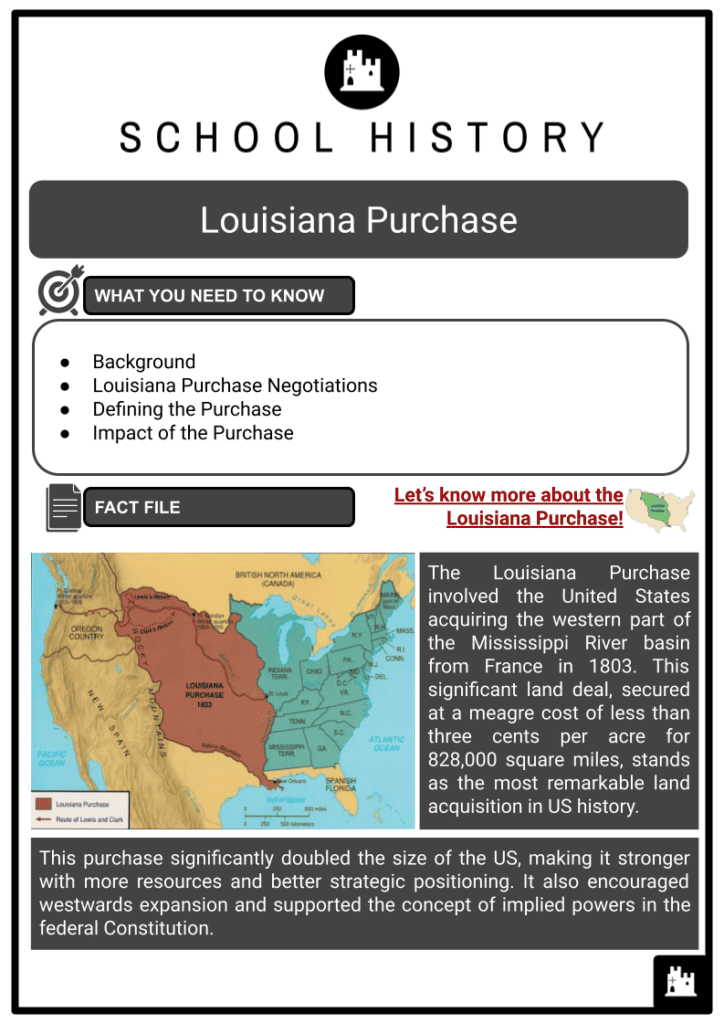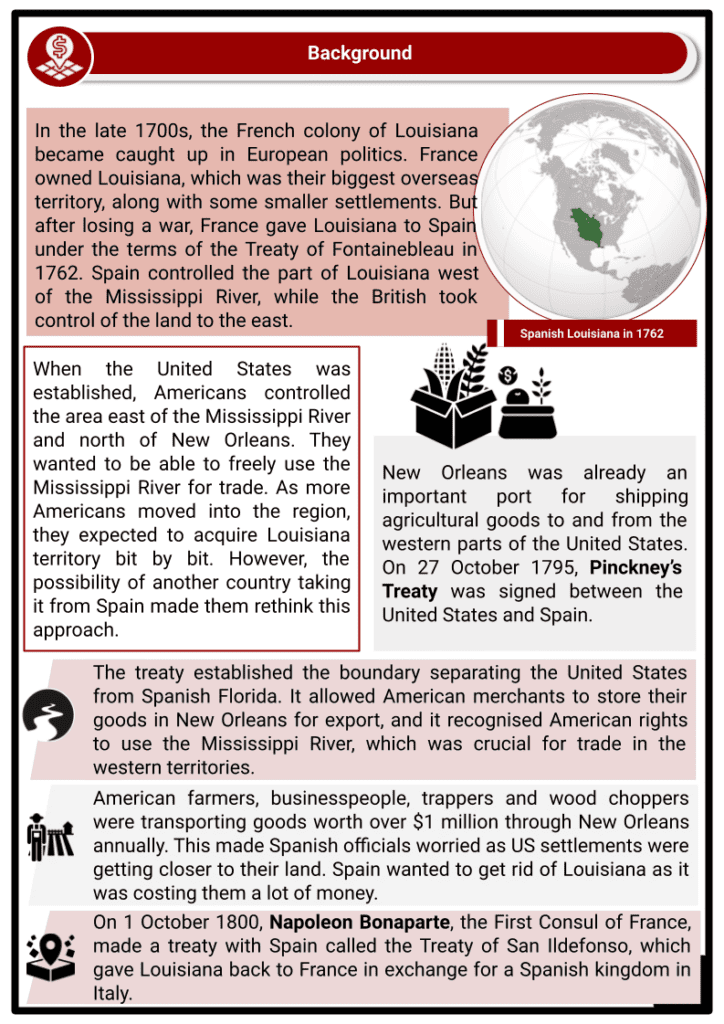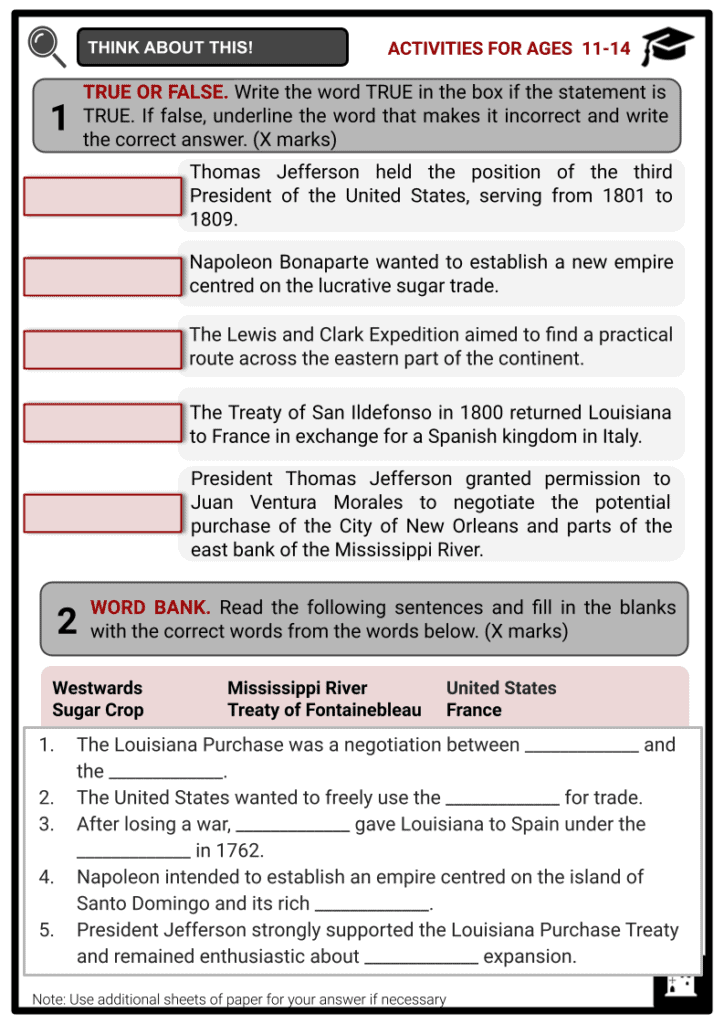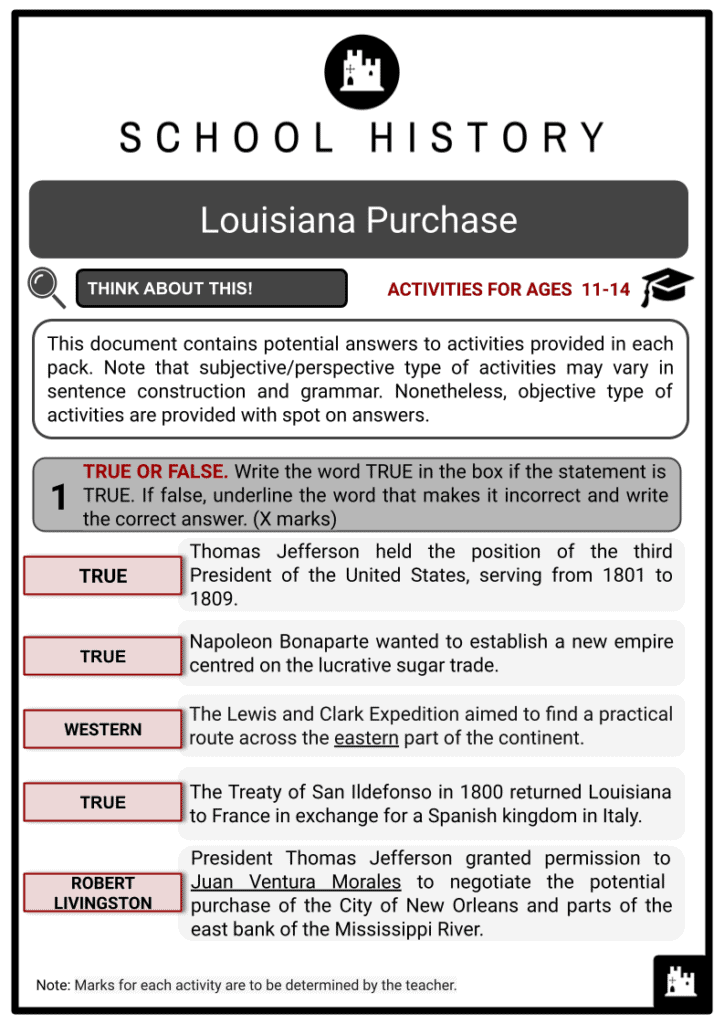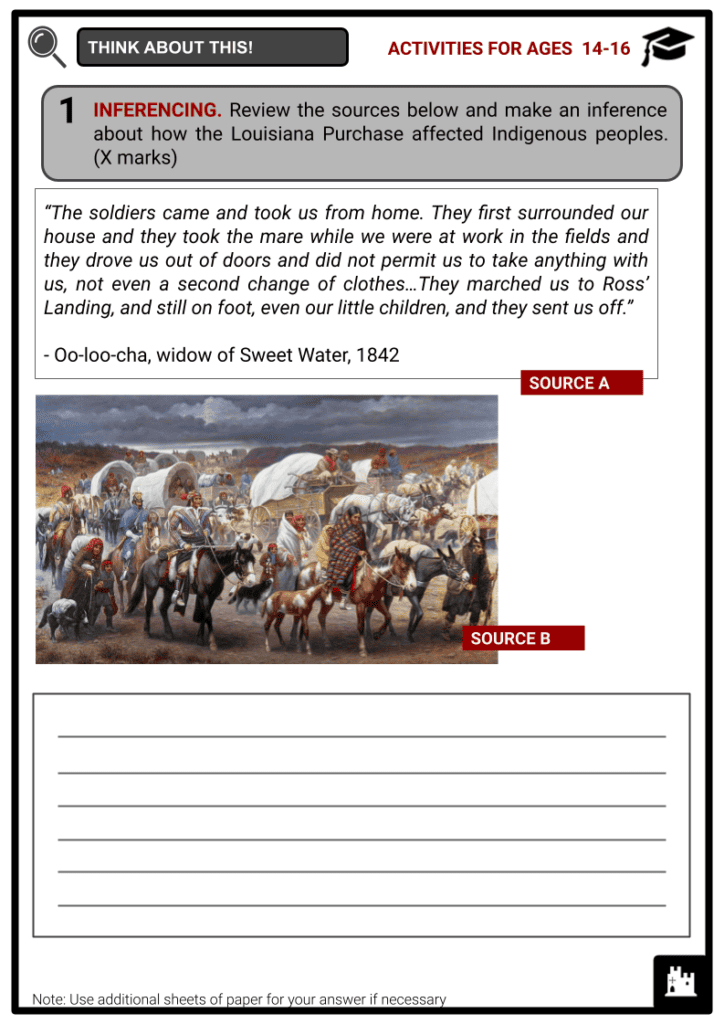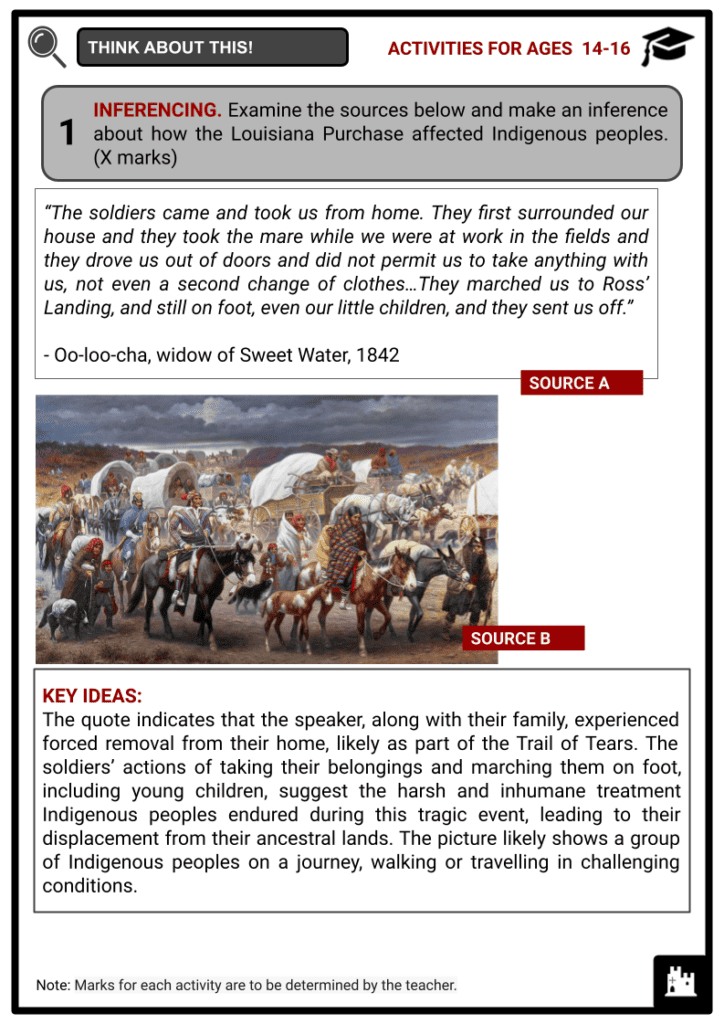Louisiana Purchase Worksheets
Do you want to save dozens of hours in time? Get your evenings and weekends back? Be able to teach about the Louisiana Purchase to your students?
Our worksheet bundle includes a fact file and printable worksheets and student activities. Perfect for both the classroom and homeschooling!
Summary
- Background
- Louisiana Purchase Negotiations
- Defining the Purchase
- Impact of the Purchase
Key Facts And Information
Let’s know more about the Louisiana Purchase!
The Louisiana Purchase involved the United States acquiring the western part of the Mississippi River basin from France in 1803. This significant land deal, secured at a meagre cost of less than three cents per acre for 828,000 square miles, stands as the most remarkable land acquisition in US history. This purchase significantly doubled the size of the US, making it stronger with more resources and better strategic positioning. It also encouraged westwards expansion and supported the concept of implied powers in the federal Constitution.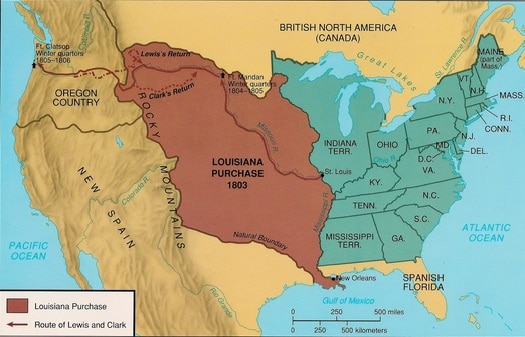
Background
- In the late 1700s, the French colony of Louisiana became caught up in European politics. France owned Louisiana, which was their biggest overseas territory, along with some smaller settlements. But after losing a war, France gave Louisiana to Spain under the terms of the Treaty of Fontainebleau in 1762. Spain controlled the part of Louisiana west of the Mississippi River, while the British took control of the land to the east.
- When the United States was established, Americans controlled the area east of the Mississippi River and north of New Orleans. They wanted to be able to freely use the Mississippi River for trade. As more Americans moved into the region, they expected to acquire Louisiana territory bit by bit. However, the possibility of another country taking it from Spain made them rethink this approach.
- New Orleans was already an important port for shipping agricultural goods to and from the western parts of the United States. On 27 October 1795, Pinckney’s Treaty was signed between the United States and Spain.
- The treaty established the boundary separating the United States from Spanish Florida. It allowed American merchants to store their goods in New Orleans for export, and it recognised American rights to use the Mississippi River, which was crucial for trade in the western territories.
- American farmers, businesspeople, trappers and wood choppers were transporting goods worth over $1 million through New Orleans annually. This made Spanish officials worried as US settlements were getting closer to their land. Spain wanted to get rid of Louisiana as it was costing them a lot of money.
- On 1 October 1800, Napoleon Bonaparte, the First Consul of France, made a treaty with Spain called the Treaty of San Ildefonso, which gave Louisiana back to France in exchange for a Spanish kingdom in Italy.
Louisiana Purchase Negotiations
- Napoleon had ambitious plans for Louisiana, aiming to establish a new empire focused on the lucrative Caribbean sugar trade.
- As part of the Treaty of Amiens in 1800, Great Britain gave back the islands of Martinique and Guadeloupe to France.
- Napoleon saw Louisiana as a strategic location for these sugar islands and as a way to prevent further US settlement in the region.
- In October 1801, he sent a military force to reclaim the important island of Santo Domingo, which had been lost during a revolt by enslaved people in the 1790s.
- Thomas Jefferson, the President of the United States, was concerned about Napoleon’s intentions to re-establish French colonies in America. He feared that if Napoleon gained control of New Orleans, he could easily block the Mississippi River, which would have a significant impact on US trade and commerce.
- Thomas Jefferson was the third President of the United States from 1801 to 1809. He was an American leader, diplomat, lawyer, architect, philosopher and Founding Father. His writings and support for human rights, freedom of speech and religion served as a great inspiration for the American Revolution. This revolution, in turn, led to the successful outcome of the American Revolutionary War.
- Jefferson granted permission to Robert R Livingston, the US Minister to France, to negotiate the potential purchase of the City of New Orleans and parts of the east bank of the Mississippi River and to secure free navigation of the river for US commerce, with a budget of up to $2 million for the negotiations.
- While the official transfer of Louisiana to French ownership had not occurred, Napoleon’s deal with the Spanish was not well-kept and became known on the frontier.
- On 18 October 1802, Juan Ventura Morales, Acting Intendant of Louisiana, publicly announced Spain’s intention to withdraw the right of deposit at New Orleans for all cargo coming from the United States.
- This closure of the port caused frustration and concern, effectively blocking commerce in the western territories.
- Despite public pressure for war with France, President Jefferson decided to take a different approach.
- He appointed James Monroe as a special envoy to Napoleon to help negotiate the acquisition of New Orleans for the United States.
- In support of this mission, Jefferson increased the authorised expenditure of funds to $10 million.
- Over the course of ten intense months of fighting in Santo Domingo, France suffered the loss of over 40,000 soldiers. This defeat in Santo Domingo prevented Napoleon’s dreams of establishing a French empire in North America.
- Moreover, Napoleon took into account the growing anti-French sentiment in the United States, where there were discussions about forming stronger ties with Great Britain.
- When Spain declined to sell Florida, it became the final tipping point for Napoleon. He shifted his focus back to Europe and saw the sale of the now-unused Louisiana as a means to acquire funds for warfare on the continent.
- Napoleon instructed his ministers, Talleyrand and Barbe-Marbois, to promptly offer the entire Louisiana territory to the United States.
- Just days before the arrival of James Monroe, the American representatives, led by Robert Livingston, were offered all of Louisiana for $15 million.
- They were initially prepared to pay only for New Orleans, so they were surprised by the larger offer. But they agreed to it, and on 30 April 1803, they signed the Louisiana Purchase Treaty.
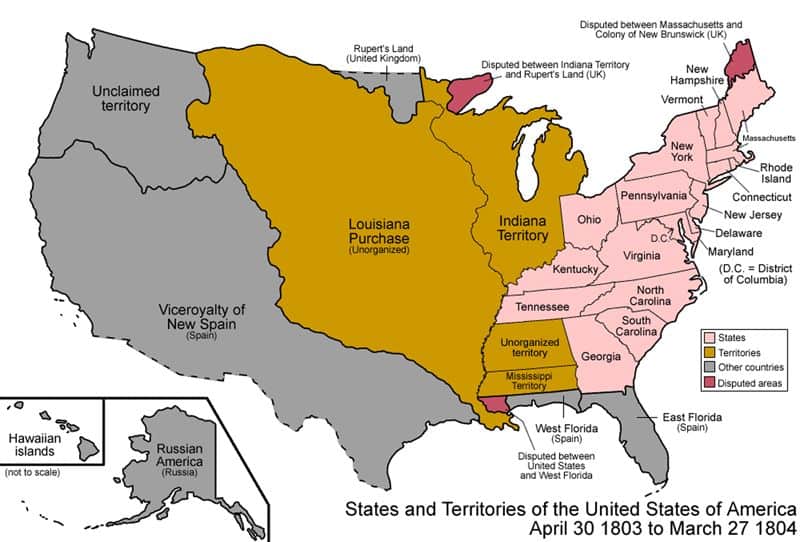
- In order to pay the required amount, the US had to borrow money from two European banks, Barings Bank and Hope & Co., at a 6% interest rate.
- The treaty announcement took place on 4 July 1803, and the documents arrived in Washington, D.C., on 14 July.
- The Louisiana Territory was vast, doubling the size of the United States, stretching from the Gulf of Mexico to Rupert’s Land and from the Mississippi River to the Rocky Mountains.
- Jefferson’s political rivals from the Federalist Party contended that the Louisiana Purchase was a worthless and uninhabitable land.
- They argued that the Constitution did not allow for the acquisition of new territory or the negotiation of treaties without the Senate’s consent.
- The Federalists were concerned about the creation of new states from the Louisiana territory, as it would strengthen the influence of Western and Southern interests in Congress, further diminishing the power of the New England Federalists in national affairs.
- However, President Jefferson strongly supported the treaty and remained enthusiastic about the westward expansion.
- Despite objections from the Federalists, the US Senate ratified the Louisiana treaty on 20 October 1803.
- In November 1803, France withdrew its troops from Saint-Domingue, ending its ambitions in the Western Hemisphere.
- On 20 December 1803, France handed over New Orleans, the colonial capital, in a ceremony at the Cabildo building, where a flag was raised in Jackson Square.
Defining the Purchase
- Shortly after the Louisiana Purchase, a disagreement emerged between Spain and the United States concerning the specific boundaries of the Louisiana territory.
- The previous treaties, including the 1762 Treaty of Fontainebleau, which transferred it from France to Spain, the 1801 Third Treaty of San Ildefonso, which returned it to France, and the 1803 Louisiana Purchase agreement, which ceded it to the United States, did not provide clear definitions of the territory’s limits, leading to the dispute.
- The United States contended that Louisiana encompassed the entire western region of the Mississippi River drainage basin, stretching to the Rocky Mountains, and also included land extending to the Rio Grande and West Florida.
- However, Spain contended that Louisiana was restricted to solely the western bank of the Mississippi River and the cities of St Louis and New Orleans. The conflict was eventually settled with the Adams-Onís Treaty of 1819, in which the United States acquired most of the territory it had claimed in the western part of the country.
- The Mississippi River served as the eastern boundary of the Louisiana Purchase, but its source was unknown at that time. Below the 31st parallel, the exact boundary was unclear, leading to a dispute between the United States and Spain. This issue was also resolved with the Adams-Onís Treaty in 1821, and today, the 31st parallel marks the northern boundary of part of Florida, and the Perdido River is the western boundary of Florida.
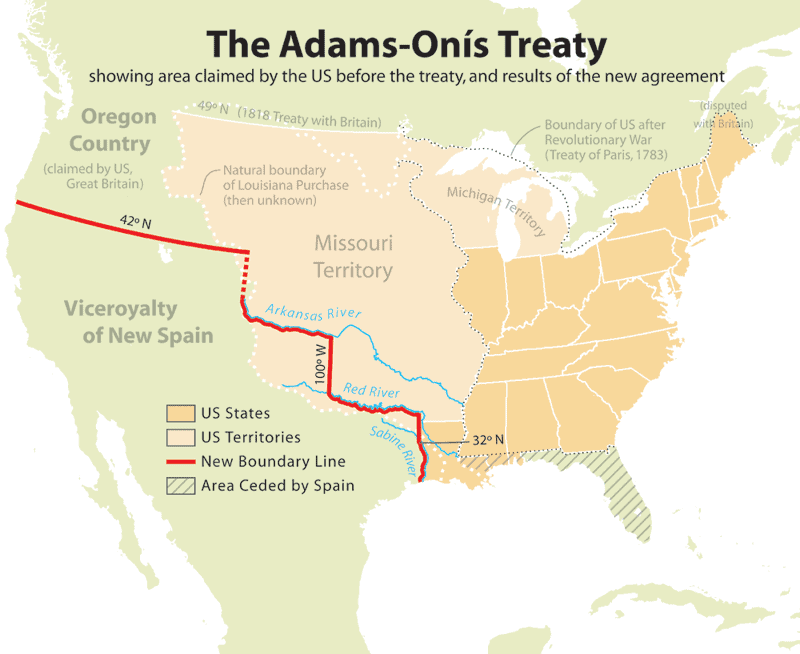
- Due to the uncertainty surrounding the western boundary of the newly acquired Louisiana territory, President Jefferson promptly initiated four expeditions to explore and map the region.
- All four missions set out from the Mississippi River. The Lewis and Clark Expedition (1804) ventured up the Missouri River, while the Red River Expedition (1806) explored the Red River basin. The Pike Expedition (1806) also began its journey up the Missouri River but later headed south to explore the Arkansas River watershed.
- The Lewis and Clark Expedition is also called the Corps of Discovery Expedition. It was an important journey by the United States to explore the newly acquired western territory after the Louisiana Purchase. Its main goals were to find a practical route across the western part of the continent and to establish an American presence in the region before European powers could lay claim.
- Furthermore, the Dunbar-Hunter Expedition (1804–1805) explored the Ouachita River watershed.
- The valuable maps and journals created by these explorers played a vital role in defining the boundaries during the negotiations that led to the Adams-Onís Treaty.
- The treaty established the western boundary as follows: starting from the Gulf of Mexico, it followed the Sabine River northwards until it intersected with the 32nd parallel.
- Then, it proceeded due north to the Red River, following the Red River until it reached the 100th meridian.
- From there, it continued north to the Arkansas River, traced the Arkansas River to its headwaters, and moved due north to the 42nd parallel. Finally, the boundary extended due west to its previous defined point.
Impact of the Purchase
- After acquiring the Louisiana Territory, governing it posed significant difficulties. The population consisted mainly of people of European descent, such as the French, Mexicans and Spanish, who were mostly Catholic. Moreover, there were a considerable number of enslaved Africans, as Spain had continued the transatlantic slave trade. During this time, many French-speaking refugees arrived in south Louisiana, escaping a major revolt by enslaved people in Saint-Domingue. Some of these refugees brought their enslaved workers with them.
- Enslavers in the Southern states were worried that acquiring the new territory might lead to revolts among enslaved individuals owned by Americans, like what had happened in Saint-Domingue. To address these concerns and support their agricultural ventures, the enslavers wanted the US government to permit the practice of slavery in the newly obtained territory.
- The Louisiana Purchase was a negotiation between France and the United States, but it did not involve consultation with the various Indigenous peoples residing on the land, and they had not given up their land to any colonial power.
- In the four decades following the purchase, many court decisions forced several Indigenous peoples to leave their lands east of the Mississippi River and resettle in the new territory, leading to the tragic Trail of Tears.
- The purchase of the Louisiana Territory sparked ongoing debates about Indigenous land rights that continued into the mid-20th century. Numerous court cases and tribal claims in the 1930s sought historical damages resulting from the Louisiana Purchase, which eventually led to the creation of the Indian Claims Commission Act (ICCA) in 1946.
Frequently Asked Questions
- What was the Louisiana Purchase?
The Louisiana Purchase was a significant land acquisition by the United States from France in 1803, involving the purchase of approximately 828,000 square miles of territory, which extended from the Mississippi River to the Rocky Mountains and from the Gulf of Mexico to the Canadian border.
- How much did the Louisiana Purchase cost?
The United States paid a total of $15 million for the Louisiana Territory. This amounted to approximately 3 cents per acre, making it one of history's most significant land deals.
- What was the main purpose of the Louisiana Purchase?
The main purpose of the Louisiana Purchase was to gain control of the port of New Orleans and secure free access to the Mississippi River for American trade and expansion. It also paved the way for significant westward expansion, doubling the size of the United States and shaping its future as a continental power.

